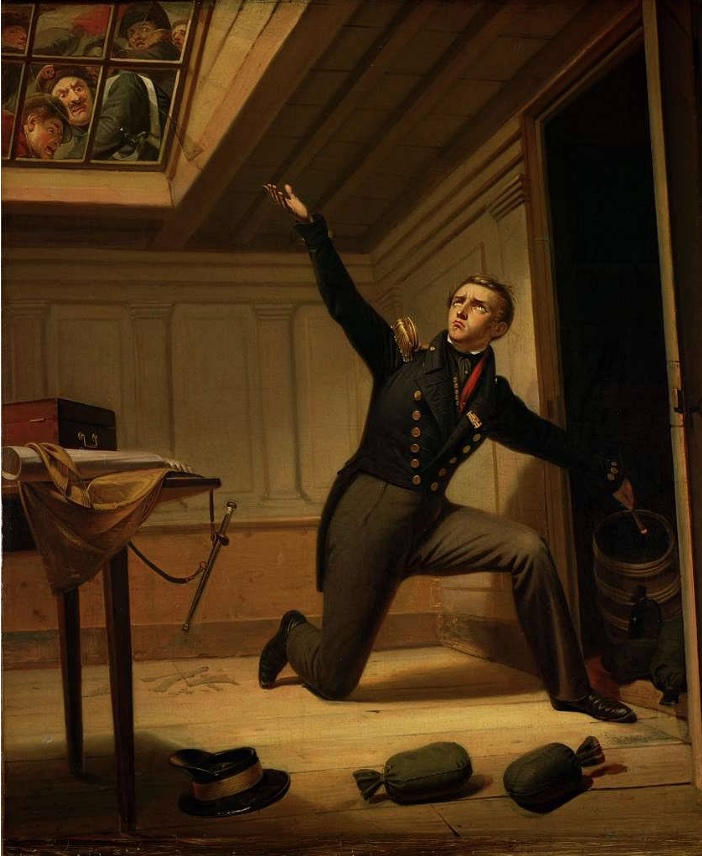
Commander Van Speyk
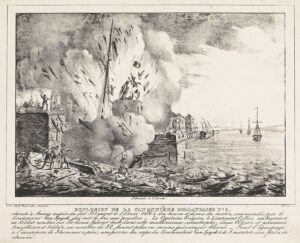
Preserving History: Van Speyk’s Portrait on a Delft Dish
On February 5, 1831, now 193 years ago, Dutch naval history was made when hero Jan C. J. van Speyk detonated his own ship. As we approach the anniversary, it’s an opportune time to share this narrative, which is greatly illustrated by a Delft faience commemorative plate featuring Van Speyk’s portrait.
Maritime history has been a popular literary and artistic theme over time, with enduring chronicles such as the that of the cartographer and explorer Willem Barentsz (1550-1597) and his crew who where stuck on Nova Zembla in the Northern Ice sea (1595-96), skipper and merchant IJsbrant Willemsz. Bontekoe (1587-1657), whose detailed travel journey of his voyage to the East Indies became the basis for the famous Dutch adventure novel ‘De Scheepsjongens van Bontekoe’ by Johan Fabricius, additionally the successes of Admiral Michiel de Ruyter (1607-1676) add further dept to maritime history.
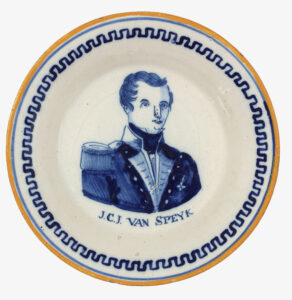
And so does the narrative of J.C.J. van Speyk (1802-1831), immortalized on this commemorative plate.
Orphaned in his youth, Van Speyk originally trained to become a tailor. He embarked on his seafaring life in 1820, when he gained entry into the Royal Dutch Navy. Following several years in the East Indies, where he earned the moniker ‘Schrik der roovers’ (fear of the robbers), Van Speyk assumed the role of commander aboard gunboat N2 during the Belgian uprising.
The Belgian uprising in 1831 was the result of Belgium’s struggle for independence from the Kingdom of the Netherlands. The roots of the uprising began with the Congress of Vienna (1814-1815), where major European powers decided to unite the Southern Netherlands (including present-day Belgium) with the Northern Netherlands to form the Kingdom of the Netherlands, under the rule of King William I.
However, discontent grew among the predominantly Catholic and French-speaking population of the Southern Netherlands due to perceived discrimination in favor of the Protestant and Dutch-speaking North. Tensions escalated, and in August 1830, a performance at the Brussels Opera sparked widespread riots, leading to the outbreak of the Belgian Revolution.
The revolutionaries, composed of a coalition of liberals, nationalists, and Catholics, sought to establish an independent and neutral Belgium. The fighting was intense, with key battles in cities like Brussels and Ghent. In September 1830, the Provisional Government of Belgium declared independence, and the struggle continued against Dutch forces.
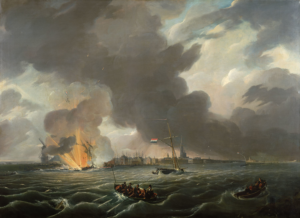
The Dutch government had ordered the blockade of the Scheldt River to prevent supplies from reaching the Belgian rebels. Van Speyk was responsible for inspecting ships traveling to and from the important harbor city of Antwerp, which had joined the uprising in October 1830. While sailing to Oosterweel to inspect shipments on February 5, 1831, a robust northwest wind and a faulty anchor caused his ship to drift on the Scheldt near Fort Sint Laurentius. Van Speyk’s ship was positioned near an agitated crowd of Antwerp workers and soldiers, some allegedly attempting to seize the ship’s flag. In response, Van Speyk retreated to the cabin, ostensibly to retrieve official documents. It was there that, by placing his cigar in a barrel of gunpowder, he ignited the ship, uttering what are now considered his historic last words: “…and become an infamous Brabander? Then I’d rather take it to the air.” While the authenticity of these words is not verifiable, they have nonetheless become widely renowned. Of his 31 crew members, 28 perished alongside him.
Van Speyk’s final resting place became the Nieuwe Kerk in Amsterdam, the coronation church of the Dutch royal family. In a decree dated February 11, 1833, it was mandated that at least one ship in the Dutch navy must forever bear the name ‘Van Speyk’. Since then, seven ships have honored this decree. Van Speyk’s sacrifice and his willingness to destroy his own ship rather than surrender to the enemy became a symbol of Dutch patriotism and resistance against the Belgian uprising. His act was celebrated in the Netherlands, where he became a national hero. While Van Speyk is remembered as a hero in Dutch history, his legacy is viewed differently in Belgium, where he is seen as a symbol of Dutch oppression during the struggle for independence.
The Belgian uprising was finally settled. International intervention played a crucial role in shaping the outcome. During the Conference of London, spanning from 1830 to 1833 and then from 1838 to 1839, the five major European powers, United Kingdom, France, Prussia, Austria, and Russia, deliberated on the aftermath of the Belgian Revolution and the partition of the United Kingdom of the Netherlands. Despite their initial reluctance, they hesitantly agreed to the dismantling of the buffer state, earlier agreed upon by the Congress of Vienna in 1815, imposing new conditions to safeguard the equilibrium of power. This pertained specifically to the form of governance, the selection of a monarch, and the commitment to neutrality by the newly independent Belgium.
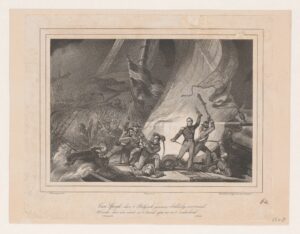
The resolution of mutual territorial disputes proved challenging, ultimately resulting in the division of Limburg and Luxembourg. Belgium was compelled to relinquish control over eastern Limburg to the Netherlands, while eastern Luxembourg remained in a personal union with the Dutch king. The Conference also addressed the allocation of the national debt and navigational privileges on the Scheldt River.
King William I of the Netherlands rejected the XVIII articles proposed by the Conference on June 26, 1831, resorting to the Ten Days’ Campaign in a bid for a military solution. Despite French intervention preventing this effort, the Conference revised the terms in the XXIV articles. This treaty, signed on November 15, 1831, by the five powers and Belgium, faced yet another refusal from William I. His abandonment of the policy of perseverance in 1838 marked a turning point, but due to Belgian resistance, it took until April 19, 1839, for the Treaty of London to finally conclude the deliberations of the Conference.
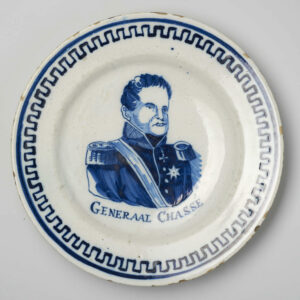
This Delft plate is most likely part of a series of plates honoring Dutch military heroes. A similar plate housed in the collection of the Open-air Museum in Arnhem, marked for ‘De Drie Klokken’ (The Three Bells) factory, depicts general Chassé, who commanded the Dutch garrison in the city of Antwerp. He gained attention for his determined defense of the city against Belgian insurgents and French forces. One of the most notable events was the Siege of Antwerp, which took place from December 1832 to February 1833. Despite facing significant challenges and dwindling supplies, Chassé valiantly held out against the besieging forces. Due to the striking resemblances between the plates, we can confidently attribute the Van Speyk plate to ‘De Drie Klokken’ as well.
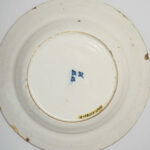
This portrait of Van Speyk depicted on Delft faience not only commemorates the dramatic event of his death, it also marks an important passage in the history of The Dutch Kingdom and our Belgian neighbors.
Main image: Jacobus Schoemaker Doyer (1807 – 1867), Van Speijk in the powder room, oil on canvas, Amsterdam Museum, inv. no. SB 4849



